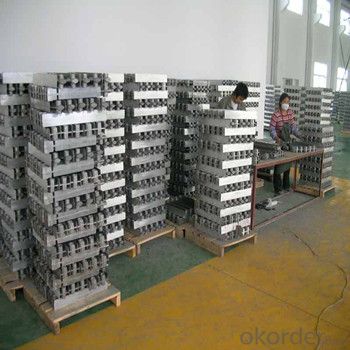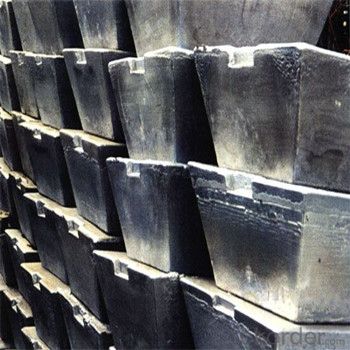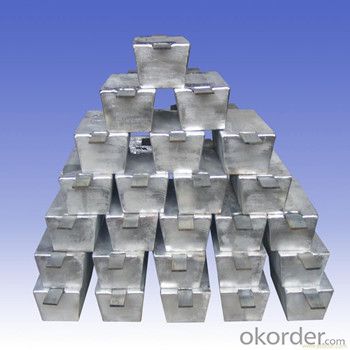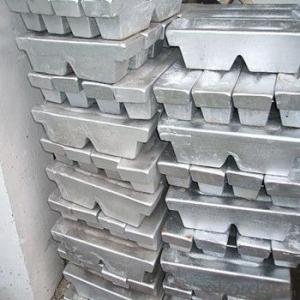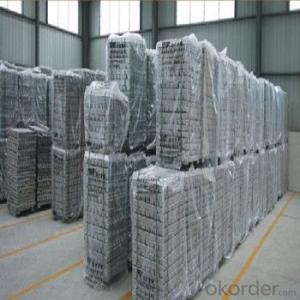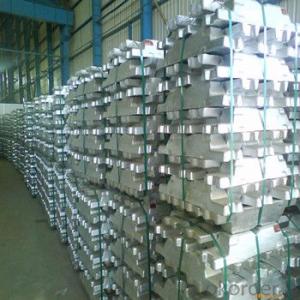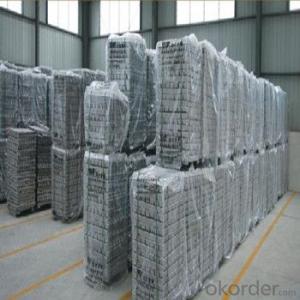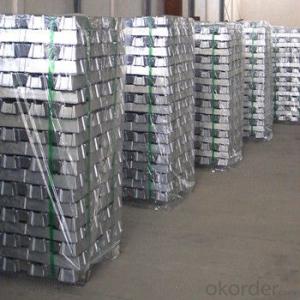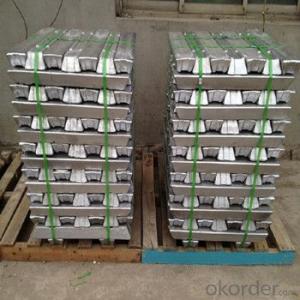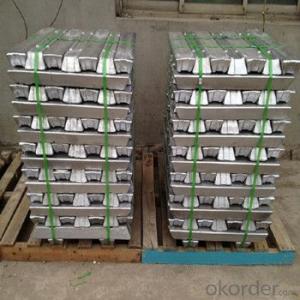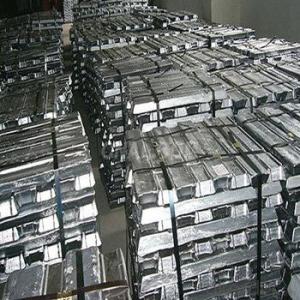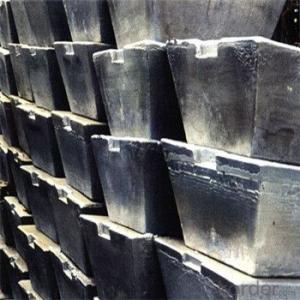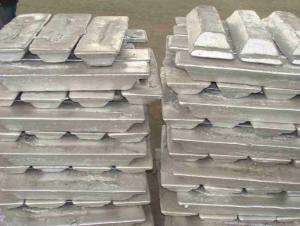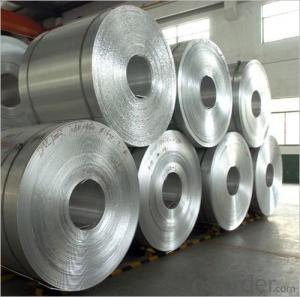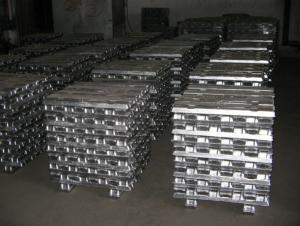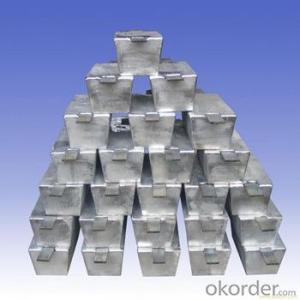Aluminium Ingot Al99.70 From Good Factory
- Loading Port:
- China main port
- Payment Terms:
- TT OR LC
- Min Order Qty:
- 1000 m.t.
- Supply Capability:
- 10000 m.t./month
OKorder Service Pledge
OKorder Financial Service
You Might Also Like
Pure Aluminum Ingot Used for Industry
1.Structure of Aluminum Ingot Description
A material that has been cast into a shape in order to be transported and processed easier than in an unprocessed form. An ingot is typically rectangular in shape, which allows it to be stacked. Ingots are most commonly associated with metals, with ingots of gold held in the vaults of banks and brokerages being popular images.
2.Main Features of the Aluminum Ingot
•High Purity
•High strength
•Fast melting
•Best price
•Good after-service
3. Aluminum Ingot Images
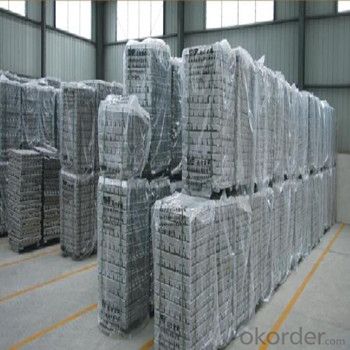
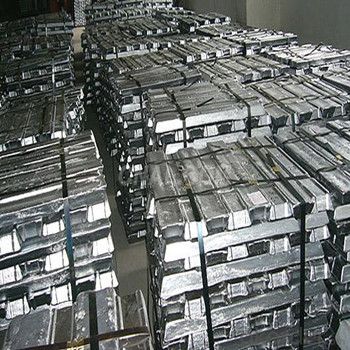
4. Aluminum Ingot Specification
Grade | Chemical Composition % | |||||||||
Al≥ | impurities ≤ | |||||||||
Si | Fe | Cu | Ga | Mg | Zn | Mn | others | Sum | ||
Al99.9 | 99.90 | 0.50 | 0.07 | 0.005 | 0.02 | 0.01 | 0.025 | - | 0.010 | 0.10 |
Al99.85 | 99.85 | 0.80 | 0.12 | 0.005 | 0.03 | 0.02 | 0.030 | - | 0.015 | 0.15 |
Al99.7 | 99.70 | 0.10 | 0.20 | 0.010 | 0.03 | 0.02 | 0.030 | - | 0.030 | 0.30 |
Al99.6 | 99.60 | 0.16 | 0.25 | 0.010 | 0.03 | 0.03 | 0.030 | - | 0.030 | 0.40 |
Al99.5 | 99.50 | 0.22 | 0.30 | 0.020 | 0.03 | 0.05 | 0.050 | - | 0.030 | 0.50 |
Al99.00 | 99.00 | 0.42 | 0.50 | 0.020 | 0.03 | 0.05 | 0.050 | - | 0.050 | 1.00 |
5.FAQ of Aluminum Ingot
We have organized several common questions for our clients,may help you sincerely:
①How about your company?
A world class manufacturer & supplier of castings forging in carbon steel and alloy steel,is one of the large-scale professional investment casting production bases in China,consisting of both casting foundry forging and machining factory. Annually more than 8000 tons Precision casting and forging parts are exported to markets in Europe,America and Japan. OEM casting and forging service available according to customer’s requirements.
②How to guarantee the quality of the products?
We have established the international advanced quality management system,every link from raw material to final product we have strict quality test;We resolutely put an end to unqualified products flowing into the market. At the same time, we will provide necessary follow-up service assurance.
③How long can we receive the product after purchase?
In the purchase of product within three working days, We will arrange the factory delivery as soon as possible. The pecific time of receiving is related to the state and position of customers.Commonly 7 to 10 working days can be served.
- Q: What are the different surface treatment options for aluminum ingots?
- There are several surface treatment options available for aluminum ingots, depending on the desired outcome and application. Some of the commonly used surface treatment options for aluminum ingots include anodizing, powder coating, polishing, and painting. Anodizing is a popular surface treatment method for aluminum ingots. It involves creating a protective oxide layer on the surface of the aluminum through an electrochemical process. Anodizing provides various benefits such as increased corrosion resistance, improved durability, and enhanced aesthetic appearance. It also allows for coloring options by dyeing the oxide layer. Powder coating is another surface treatment option for aluminum ingots. It involves applying a dry powder coating to the surface of the aluminum and then curing it in an oven. The powder adheres to the surface electrostatically and creates a durable and protective layer. Powder coating offers excellent resistance to impacts, chemicals, and weather conditions. It is available in a wide range of colors and finishes. Polishing is a surface treatment method that involves smoothing and shining the surface of aluminum ingots. It is achieved by using abrasive materials and techniques to remove any imperfections, scratches, or dullness. Polishing enhances the aesthetic appearance of aluminum, giving it a mirror-like or satin finish. Painting is a surface treatment option that involves applying a liquid paint coating to the surface of aluminum ingots. It can provide both protection and decoration. Painting allows for a wide range of colors and finishes, providing flexibility in design and customization. It is commonly used for architectural applications, outdoor furniture, and automotive parts. In addition to these surface treatment options, aluminum ingots can also undergo other treatments like brushing, sandblasting, and etching. These methods can offer unique finishes and textures to the aluminum surface, depending on the specific requirements of the application. Overall, the choice of surface treatment for aluminum ingots depends on factors such as the desired appearance, functionality, and the environment in which the aluminum will be used. Each treatment option has its own advantages and considerations, so it is essential to carefully evaluate the requirements before selecting the most appropriate surface treatment method.
- Q: How are aluminum ingots used in the production of transportation vehicles?
- Aluminum ingots play a crucial role in the production of transportation vehicles, especially in the automotive and aerospace industries. These ingots are melted down and cast into various components that are lightweight, yet strong and durable. In automotive manufacturing, aluminum ingots are primarily used to produce engine blocks, cylinder heads, and transmission casings. The lightweight nature of aluminum allows vehicles to achieve better fuel efficiency and lower emissions. Additionally, aluminum's high strength-to-weight ratio enhances the overall performance and safety of the vehicle. Aluminum ingots are also utilized in the aerospace industry for the construction of aircraft components. These ingots are transformed into structural parts such as wing panels, fuselage sections, and landing gear. The lightweight properties of aluminum contribute to increased fuel efficiency, enabling aircraft to carry more passengers or cargo over longer distances. Furthermore, aluminum ingots are employed in the production of railway and marine vehicles. In railways, aluminum components are used for train bodies, doors, and windows, enhancing both speed and energy efficiency. Similarly, aluminum ingots are utilized in marine vessels for constructing hulls, decks, and superstructures, contributing to better maneuverability, fuel economy, and corrosion resistance. The use of aluminum ingots in transportation vehicles offers numerous advantages, including improved performance, reduced weight, enhanced fuel efficiency, and increased durability. As a result, the demand for aluminum ingots in the transportation industry continues to grow, driving innovation and advancements in materials engineering.
- Q: How to make aluminium box into aluminium ingot?
- The problem of aluminum is not high, it can be dissolved directly with a dry pan, but it should not be dissolved directly. Because the aluminum ingot is pure aluminum, and the aluminum box should have impurities. The smoke isn't too big.
- Q: What are the basic equipments for the production of aluminium ingots?
- If you want to match the very homogeneous ingot aluminum melting furnace, automatic machine, automatic folding spindle machine, environmental protection equipment, forklift, spectrum analyzer, loadometer, refining machine etc..
- Q: What are the main factors influencing the choice between aluminum ingots and aluminum slabs?
- The choice between aluminum ingots and aluminum slabs can be influenced by several factors. Firstly, the production process plays a crucial role. Ingots are commonly used for casting and shaping purposes due to their easy meltability and moldability. On the other hand, slabs are often utilized in rolling and extrusion processes to create thin sheets or various shapes. Secondly, the specific requirements of the end product can impact the decision. If the final product needs a particular shape or thickness, slabs may be preferred as they can be directly processed into the desired dimensions. However, if the product requires casting into complex shapes, ingots may be more suitable. Moreover, cost considerations also come into play. Ingots are generally cheaper to produce as they require less processing and have fewer quality requirements. Conversely, slabs may involve additional steps like rolling or extrusion, which can increase production costs. Market demand is another essential factor. If there is a higher demand for products derived from slabs, such as sheet metal or extruded profiles, then slabs would be preferred to meet the market needs efficiently. Additionally, the available production capacity and resources of a manufacturer can influence the decision. If a company has the necessary machinery and capabilities to process aluminum slabs efficiently, it may choose slabs over ingots to maximize its production capacity and resources. In conclusion, manufacturers must carefully evaluate the production process, product requirements, cost considerations, market demand, and available resources to make an informed decision regarding the use of aluminum ingots or slabs. By considering these factors, they can align their production capabilities with market demands effectively.
- Q: What are the advantages of the CNC process for aluminum and die cast aluminum?
- Aluminum processing, aluminum and other common such as screen. It is used extrusion process, that is, aluminum ingots and other raw materials in the melting furnace, after extrusion extruder extrusion die molding, it can also extrude a variety of profiles of different sections.
- Q: What are the different recycling methods for aluminum ingots?
- There are several recycling methods for aluminum ingots, including mechanical recycling, which involves melting the ingots and then casting them into new shapes; chemical recycling, where the ingots are dissolved in a chemical solution to separate impurities and recover pure aluminum; and electrolytic recycling, which uses an electric current to separate aluminum from other metals in the ingots. These methods help to minimize waste and conserve resources by allowing aluminum to be reused and repurposed.
- Q: What is the melting point of aluminum ingots?
- The melting point of aluminum ingots is approximately 660.3 degrees Celsius or 1220.5 degrees Fahrenheit.
- Q: Can aluminum ingots be used in 3D printing?
- Indeed, aluminum ingots have the ability to be utilized in the realm of 3D printing. The reason behind this lies in the fact that aluminum possesses attributes such as being lightweight, possessing high strength, and exhibiting exceptional thermal conductivity. Nevertheless, instead of employing aluminum ingots directly, a technique known as powder bed fusion comes into play. More specifically, one can utilize selective laser melting (SLM) or electron beam melting (EBM) within this process. The modus operandi is as follows: fine aluminum powder is evenly distributed in thin layers, subsequently being selectively melted through the application of a laser or electron beam, layer by layer, in order to achieve the desired 3D object. This method enables the production of intricate geometries and exact parts, all while maintaining an elevated level of strength and precision.
- Q: What are the scouring agents in the die casting process, such as slag remover, coating agent, flux, and what matters should be paid attention to when the aluminium ingot is dissolved?,
- scouring agentFor refining alloy liquid, the main purpose is to remove the gas inside the liquid metal liquid, raise the density of the aluminum liquid die-casting
Send your message to us
Aluminium Ingot Al99.70 From Good Factory
- Loading Port:
- China main port
- Payment Terms:
- TT OR LC
- Min Order Qty:
- 1000 m.t.
- Supply Capability:
- 10000 m.t./month
OKorder Service Pledge
OKorder Financial Service
Similar products
Hot products
Hot Searches
Related keywords



